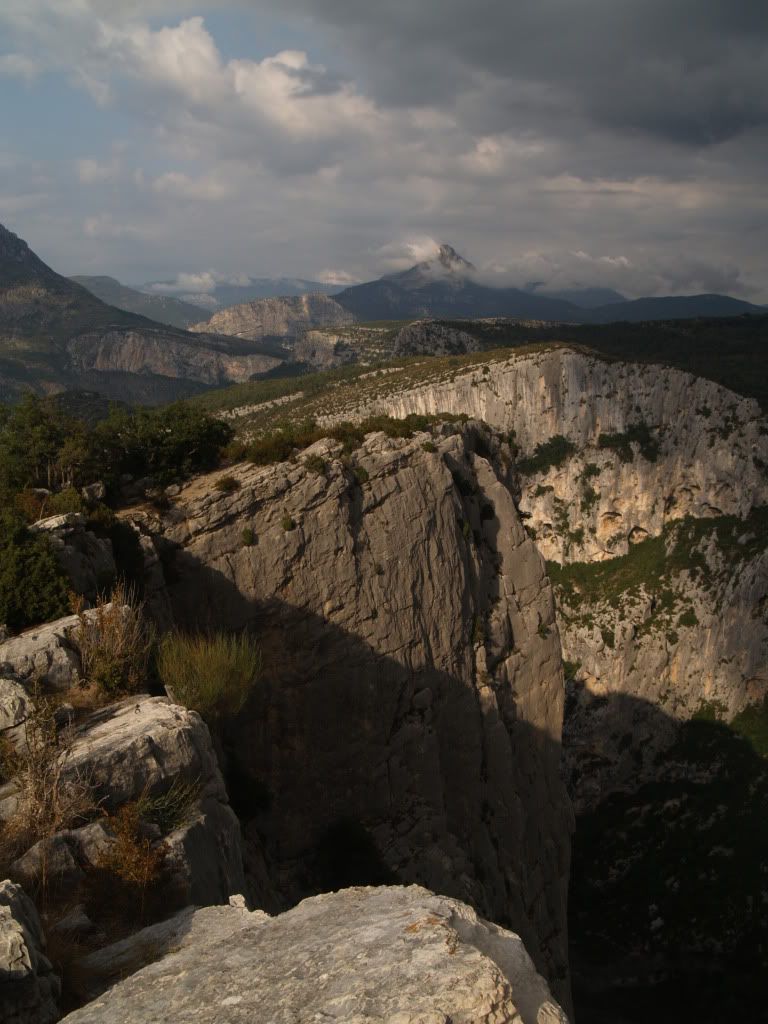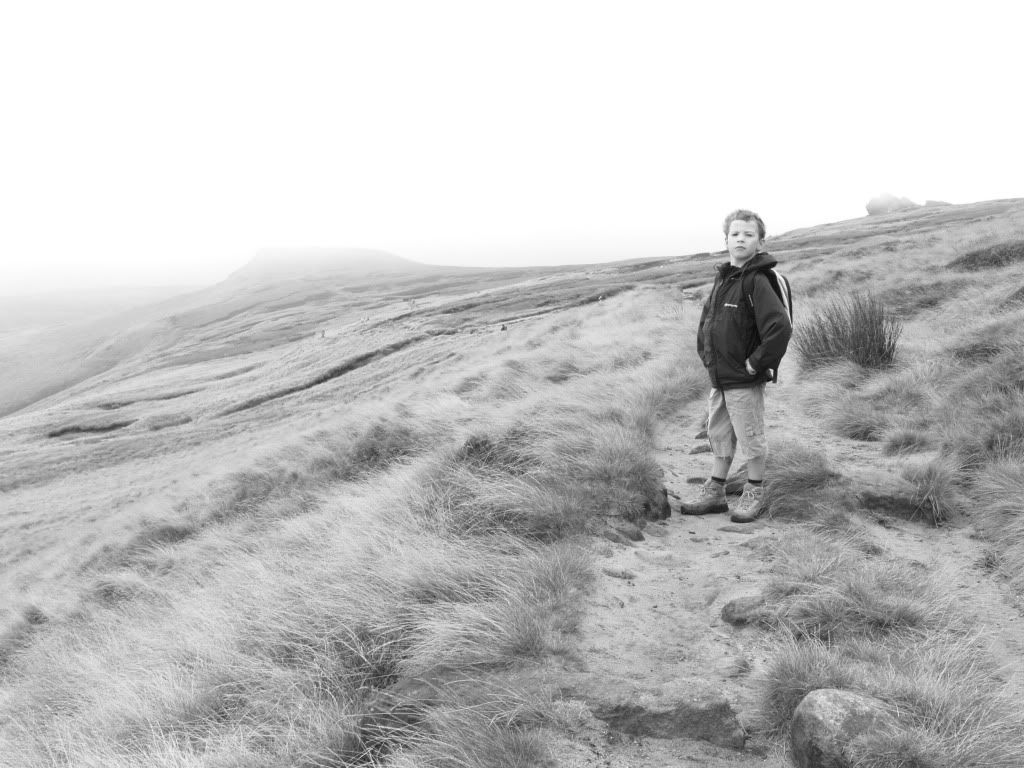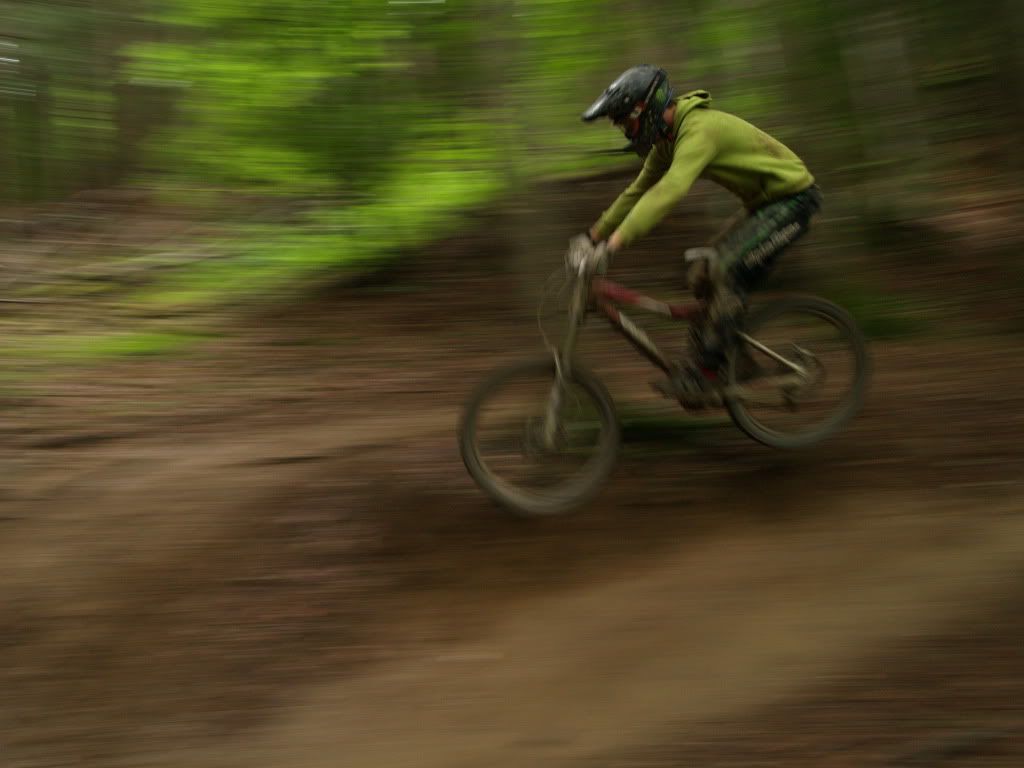The Hub Photo Club
Comments
-
-
wow what did you do to get the image like that? Was it just about reducing the exposure down a bit? or did you have to do a lot?0
-
In that last photo of mine you mean?
If so, then it's basically a blending of multiple exposures. The dynamic range on a camera is not wide enough to capture the sunset, without losing all the foreground in shadow, or capturing the foreground, without burning out the sunset.
So, several shots are taken and stacked on top of each other, then you can blend between them to get the right bits properly exposed.0 -
oh cool nice stuff, I was wondering how you got so much detail without washing other bits out.
Im starting to get into photography and making more of an effort than just point a shoot when I take pictures, its a pretty cool subject.0 -
this is prob one of my favourites that I took:
 0
0 -
and prob this panoramic one too:

I think I used a similar multi picture technique to Yeehaa here. I just took them as lots of pictures in there own right and let the panoramic stitching do the work balancing out the differences for me. It worked out quite well.0 -
Nice. I tried doing the insect stuff last summer, but never got the timing right. Plus with my macro lens, if you so much as breathe, the focusing goes right out

looks like you got the focusing bang on on that one, good shot.
If you want any techniques or help, feel free to ask. I'm by no means an expert, but I'll try and help if I can.0 -
jairaj wrote:and prob this panoramic one too:

I think I used a similar multi picture technique to Yeehaa here. I just took them as lots of pictures in there own right and let the panoramic stitching do the work balancing out the differences for me. It worked out quite well.
OOOOOH, I like that one a lot
The difference between that, and my sunset one from above though, is that all the shots for the sunset were taken at a fixed focal distance, on a tripod. So I can stack them up and mask out the bits I want.
I went a bit over-zealous with a panorama shot of Loch Morlich too, it ended up so wide that Flickr has made it tiny to fit in the size restrictions (although to be fair, the TIFF file is several hundred megabytes)
(although to be fair, the TIFF file is several hundred megabytes)
In this instance, I used photoshop's stitching, so I could do it with RAW files from the camera, giving me more exposure tweak-ability - whereas I usually find that windows live gallery does a better job of panoramic stitching 0
0 -
A lot of people seem to be playing with contrast and saturation in pics - your top one reminds me a little of this on Wharncliffe chase:
http://www.flickr.com/photos/andyheming ... otostream/
Not overdone, but certainly gives it a 'feel'.0 -
supersonic wrote:Not overdone, but certainly gives it a 'feel'.
I think that's what its all about. You seem to get better depth and contrast, almost making the picture feel 3D. When I see pictures like that I feel like I'm inside the scene and feel part of it.0 -
Awwwwww. All this photography talk has me pining over a new lens that I can't afford (again)
This time, my attention is on the Zeiss 135mm prime, or the Zeiss 16-35mm f2.8
Both at over a grand 0
0 -
Here are some from over the years but most of the good stuff is on slide and I haven't got round to transfering the many thousands of slides yet

Verdon France
My son on Kinder Scout, Peak District
I just like the colours on this
What I used to do ( all the time )I'm going to blow the bank on a new build ( within reason ) NOW DONE!!
http://i570.photobucket.com/albums/ss14 ... 010362.jpg0 -
Richie, is that last one you with a perm?
 0
0 -
Ooh, you might be able to answer something I've been wondering about then.Richie63 wrote:Here are some from over the years but most of the good stuff is on slide and I haven't got round to transfering the many thousands of slides yet
I've got a 35mm film slr, and was considering getting some slide film for it to try out, since I've heard that slide film gives greater dynamic range, and more clarity than normal film.
But, how is it developed? Does it only give transparent slides, or can it also be developed into "normal" photographs?
lovely shots too, by the way. Liking the top one, beautiful colours.0 -
-
Replies to above
CWNT no that is Dougie Hall climbing on Raventor in the Peak District - though I can post pictures of me with a perm.
Jay12 wrong picture caption you are reading there.
YeeHaamcgee Slide film gives you slides, you give the slides to a lab then they produce prints etc from them.
Having slides is a bit of a pain in this digital age as it's a right old fk about to get them on to the computer to use. I've got a Nikon slide scanner but it only has a SCUSI lead and my current machine does not have this connection. Finding a decent scanner is expensive.I'm going to blow the bank on a new build ( within reason ) NOW DONE!!
http://i570.photobucket.com/albums/ss14 ... 010362.jpg0 -
thanks for the info, Richie63.
So if I buy slide film, say like Fuji Velvia 50, I can still have the photos as prints, from a lab? (as well as have the slides)0 -
yeehaamcgee wrote:Ooh, you might be able to answer something I've been wondering about then.
I've got a 35mm film slr, and was considering getting some slide film for it to try out, since I've heard that slide film gives greater dynamic range, and more clarity than normal film.
But, how is it developed? Does it only give transparent slides, or can it also be developed into "normal" photographs?
Slide film has far less dynamic range than colour neg film - almost as bad as Digital in fact.
It's popularity was due to the fact that it usually gave better colour saturation, though towards the end of the film-era there really wasn't much in it: Fuji's excellent range of films were so good that i went over to using 'amateur' colour neg film for 80% of my commercial work as it was far more stable on long trips in various climates.
Most slide film will be E-6 process now that Kodachrome is dead, whereas colour neg is C-41 process (different chemicals).
Most colour labs used to run two or more machines, but now they may only run one using C-41 and will dump the chemistry once a week to put through a run of E-6 which is far less common now.
Some bigger commercial labs will still run multiple processors, but their prices will reflect this.
You can 'cross-process' both films (i.e. in the 'wrong' chemistry) but it'll still give you negs from neg film and trannies from tranny film - the colours will be a bit whacky, that's all.
if you want to shoot medium-format, I'd go for a commrcial lab anyway as they'll be able to scan to a higher resolution than a high-street lab.
Home scanners vary in price - the better (i.e. professional quality) ones are in the region of £2,000 still...0 -
yeehaamcgee wrote:thanks for the info, Richie63.
So if I buy slide film, say like Fuji Velvia 50, I can still have the photos as prints, from a lab? (as well as have the slides)
No.
You can get prints made from slides but it's way more expensive and usually not offered by high-street labs nowaqdays.0 -
Oh god no, not medium format. I've been given an old minolta Dynax 35mm SLR, and since all bar one of my lenses work with it, I just fancy experimenting with it.
I've never used film before, apart from an old compact camera when I was a child, so excuse my ignorance
So, you say that film has a greater dynamic range than modern DSLRs? This is in stark contrast to what I've read. :?0 -
I don't know where you got that information but it's flawed. Have a pop over to the 'photography forum'...http://www.photography-forum.org/index.php
Film - B&W negative film - will record something like 14 stops EV (black to white and levels in between.
A print will only resolve about 2/3 of that information as the paper's dynamic range is more limited - which is why photographers spent hours in darkroom dodging and burning prints to get as much information as possible from the negative onto the paper.
Colour slide film will only resolve about 8 or 9 EV, but you 'get' all of that information (unless you print it, thus losing information).
Modern - i.e. current gen. DSLRs typically resolve about the same as 'old' slide film - as late as only 2007 they resolved far less, which is why you get a 'new' generation of DSLR every couple of years - bigger sensors, more megapixels, higher-iso capability have been the buzzwords til now - next step is increasing dynamic range so that you can record highlights and shadow areas without resorting to HDR or 'image-stacking'.0 -
I beg to differ, but DSLR sensors haven't changed size since their inception. My sister's very early EOS 350d has the same APS-C sized sensor as modern DSLRs, like the EOS60D. And the top end have always been 35mm full-frame.
I've just checked the stats for my Alpha, which shows it having around 9.4EV of standard range, but in practice, I can easily pull an extra 3 to 4 EV back in the highlights to bring back some detail in the sky, by adjusting the response curves. This is not typical of mid-range SLRs, since the dynamic range of this particular camera punches way above it's weight, but an usable range of, say 11-12EV, with the extreme far reaches at 13EV seems pretty damned reasonable to me, for a circa £500 camera.
There is no doubting that cameras in the EOS5D range and above will decimate this little critter, with their reduced noise, and lower pixel density.0 -
You can differ all you like: you're wrong, plain and simple. But then you're a Sony Alpha user and that's to be expected.
Top end DSLRs have not 'always' been full-frame.
I've used top end DSLRs since the early Kodak models costing £16,000. They had 1.6 megapixels and the sensors were developed by Kodak and shoehorned into converted Nikon F5 bodies with huge battery-packs bolted onto the bottom.
After that I went through Nikon's D1, D1x D2x D3 and D3x models over the past 11 years. Only D3 and D3x have full-frame (or FX) sensors, the earlier cameras had DX sensors instead which gave a magnification ratio of 1.5 when using lenses optimised for 35mm.
I've been a pro photographer for 37 years.
Full-frame sensors have only neen available on commercial cameras for the past four years or so.
The current D3s and D3x share the same size sensor and have approximately 12.1 and 24,3 Mpx respectively (be wary of 'claimed' Mpx counts as they tend not to count the effective Mpx which is usually slightly less than actual). D3 is optimised for low light and fast speed so has a lower pixel density than the D3x which is geared towards studio and portrait use.
You might know your stuff when it comes to bikes but this is my job.
If you like i'll get onto Nikon UK for an official answer for you.0 -
Nice, personal attacks :roll:Arkady001 wrote:You can differ all you like: you're wrong, plain and simple. But then you're a Sony Alpha user and that's to be expected.
You know, I was going to ask you to confirm whether the EOS 1D had always been full frame, but now I realise you're a jackass, I won't bother.
Really? Fascinating. And how long have you been an asshole?Arkady001 wrote:I've been a pro photographer for 37 years.0 -
yeehaamcgee wrote:
Nice, personal attacks :roll:Arkady001 wrote:You can differ all you like: you're wrong, plain and simple. But then you're a Sony Alpha user and that's to be expected.
You know, I was going to ask you to confirm whether the EOS 1D had always been full frame, but now I realise you're a jackass, I won't bother.
Really? Fascinating. And how long have you been an asshole?Arkady001 wrote:I've been a pro photographer for 37 years.
Gee...someone tries to help you out and throws in a bit of light banter and you resort to this?
You are a spectacularly unpleasant person. What manner of childhood trauma was it that cased you to be such an objectionable turd?
In answer to your question, i'm pretty sure the EOS-1D had 3/4 size sensor until the MkIII variant, but as I'm not a Canon user I'd have to check with one of my colleagues who has used them.
You really need to lighten up, kid - not everyone's out to get you.
Oh, and I've been an utter and complete asshole for 48 years - since my birth, in fact.0 -
Give it a rest, I thought I was talking with someone more knowledgable than myself, and was hoping to learn something, not stepping on the toes of some elitist snob with a superiority complex.0
-
yeehaamcgee wrote:Give it a rest, I thought I was talking with someone more knowledgable than myself, and was hoping to learn something, not stepping on the toes of some elitist snob with a superiority complex.
You're a funny guy - I like you.
Oh wait... :?
Anyway in answer to your question,
EOS-1Ds is full frame with an 11.4Mpx CMOS sensor - introduced in 2002, so a year later than Nikon's D1x which was 1.3 crop.
Nikon's first FX body was the D3, introduced in 2007.
EOS-5D is full frame
EOS-1DMk-whatever is 1.3 crop
Leica-users - they're the real elitists...0 -
All this talk of slides has made me rummage out some work I did along time ago,
but as you can see the years have not been to happy with the colours
anyway
Some Mag covers I did for one of the Uk's climbing journals
Showing the affects of time, there is a loss of the blue to dark grey/blue I'm going to blow the bank on a new build ( within reason ) NOW DONE!!
I'm going to blow the bank on a new build ( within reason ) NOW DONE!!
http://i570.photobucket.com/albums/ss14 ... 010362.jpg0 -
Leica? You've got to be kidding me, Hasselblad surely.
So the standard EOS1D is not full frame, only the 1Ds? I did not know that.
Seems like a strange product tree that has the 5D range being full frame, then the 1D above it being crop, then the 1DS above that again being full frame :?
Mind you, I am completely confused with canon's current range, the 60D offers very little advantage over the 550D, but is almost double the price.
That's got nothing on Sony though, who now have about 3 hundred million cameras all in the same price range, and the same resolution range, all with slightly different features, and then their NEX range, which is awesome, except they cost more than similar specced DSLRs :shock: :? :x
No idea about Nikon's range. I've used a D50, and whatever their full frame model was called (it wasn't mine, I got lent it). At least, I assume it was full frame, it was about the size of a breeze block, and the 50mm prime lens gave a much wider field of view than a 50mm my crop alpha.
So, anyway. If I get some rolls of Fuji velvia 50, to fiddle with in my Dynax, and possibly my sister's old Canon A1, I can get prints developed that I can see without using a slide projector?
I have no means to view slides, although I do have a Canon scanner, I don't think it would give great results.0


